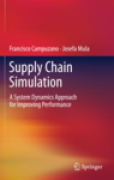
Supply chain simulation: a system dynamics approach for improving performance
Campuzano, Francisco
Mula, Josefa
Supply Chain Simulation allows readers to practice modeling and simulating a multi-level supply chain. The chapters are a combination of the practical and the theoretical, covering:. knowledge of simulation methods and techniques, the conceptual framework of a typical supply chain, the main concepts of system dynamics, and a set of practice problems with their corresponding solutions. The problem set includes illustrations and graphs relating to the simulation results of the Vensim® program, the main code of which is also provided. The examples used are a valuable simulation tool that can be modified and extended according to user requirements. The objective of Supply Chain Simulation is to meet the demands of supply chain simulation or similar courses taught at the postgraduate level. The “what if” analysis recreates different simulation scenarios to improve the decision-making process in terms of supply chain performance, making the book useful not only for postgraduate students, but also for industrial practitioners. Shows readers how to simulate a multi-level supply chain by using the system dynamics methodology. Includes illustrations and graphs related to simulation results from the Vensim program, whose main programming code is also provided. Contains practice problems and solutions. INDICE: 1. Introduction to Supply Chain Simulation. 2. Conceptual Framework for Supply Chain Simulation. 3. Bullwhip Effect in Supply Chains. 4. System Dynamics: Main Concepts. 5. Starting to Model the Supply Chain. Warehouse Management. 6. Modeling a Traditional Supply Chain by Using Causal Loop Diagrams. 7. Getting into Practice. Modeling an Entire Traditional Supply Chain.
- ISBN: 978-0-85729-718-1
- Editorial: Springer London
- Encuadernacion: Cartoné
- Páginas: 136
- Fecha Publicación: 31/07/2011
- Nº Volúmenes: 1
- Idioma: Inglés
